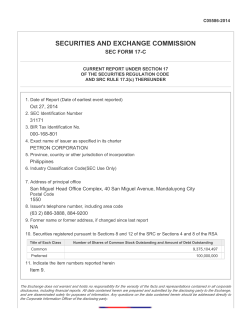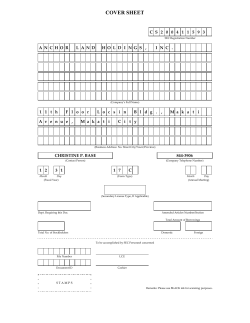
Earnings Per Share (EPS)
Earnings Per Share (EPS) RCJ Chapter 15 (836-842) Key Issues 1. 2. 3. 4. 5. 6. 7. 8. Basic EPS Weighted average common shares Pecking order Treasury stock transactions Dilution Diluted EPS options and warrants: treasury stock method Convertible bonds and preferred stock: if converted method 9. Determining dilution vs anti-dilution Paul Zarowin 2 Basic EPS Basic EPS Net income - Preferred dividends Weighted average number of common stock outstandin g weight shares outstanding by fraction of year; changes due to share repos, issuances, option exercises, etc.. Paul Zarowin 3 Basic EPS - Example On January 1, 2001 Solomon Corporation had: 160,000 common shares outstanding. 10,000 preferred shares, $100 par value, 7% On September 1, 2001 the company issued 40,000 additional common shares. The net income for 2001: $1,257,331 What is the basic EPS? Preferred dividends = 10,000 x 100 x0.07 = $70,000 (a) Shares (b) Portion Weighted shares Time span outstanding of year (col. a x col. b) Jan 1 - Aug 31 160,000 2/3 106,667 Sep1 - Dec 31 200,000 1/3 66,667 173,333 Basic EPS $1,257,331 - $70,000 $6.85 per share 173,334 shares 4 Basic EPS (cont’d) EPS is from common shareholders’ viewpoint Pecking order of suppliers of capital: 1. Debt holders 2. Preferred stock holders 3. Common stock holders Why are preferred dividends subtracted, but not bond interest? Ex. E15-14; P15-4 Paul Zarowin 5 Effect of Treasury Stock Transactions 1. Purchase of treasury shares: DR Treasury stock (contra O/E A/C) CR Cash 2. resale of treasury shares: or DR Cash DR APC CR CR Treasury stock (at cost, from 1.) APC DR (or CR) to APC is economic loss (or gain) that is not recognized in accounting Paul Zarowin 6 Effect of Treasury Stock Transactions (cont’d) Key point: Transactions in own common stock don’t affect NI (proprietary viewpoint), only affect number of shares outstanding; so firms can manipulate EPS Q:How does transaction timing during the year affect EPS? Ex. E15-16; P15-8 Paul Zarowin 7 Diluted EPS SFAS No. 128 requires companies with complex capital structures to compute another measure called diluted earnings per share. Diluted EPS = Income adjustments due to Net income - Preferred dividends + dilutive financial instruments Weighted average number of common shares outstanding + Newly issuable shares due to dilutive financial instruments (1) Options; and (2) Convertible securities can: Only dilutive securities Decrease EPS dilutive are included in the diluted Increase EPS anti-dilutive EPS calculation Paul Zarowin 8 Conversion Ratio Conversion ratio = Income adjustments due to dilutive financial instruments Newly issuable shares due to dilutive financial instruments The dilutive effect of financial instruments (for example, options warrants, and convertible bonds) on EPS is calculated starting with the instrument with the lowest conversion rate (i.e. most dilutive), and working up to the instrument with the highest conversion rate (i.e. least dilutive). Paul Zarowin 9 Step 1: calculate the effect of options and warrants on EPS Treasury Method: Q: Option exercise price < Market price No Yes Options have dilutive effect include them in diluted EPS: 1. Assume all options are exercised add new shares. 2. Assume proceeds (# shares x exercise price) are used to repurchase previously issued common shares subtract these shares. Paul Zarowin Options do not have dilutive effect not included in diluted EPS. 10 Example: Now assume that Solomon Corporation issued options to buy 20,000 shares of common stock at $100 per share. The market price is $114. What is the diluted EPS? Option exercise price 100$ < Market price 114$ Upon full exercise of option additional 20,000 shares The proceeds 20,000 X $100 = $2,000,000 are assumed to be used to repurchase previously issued common shares at the $114 market price. $2,000,000 17,544 shares $114 per share The dilution effect: 20,000 – 17,544 = 2,456 shares Diluted EPS $1,257,331 - 70,000 $6.75 per share 173,334 2,456 Step 2: calculate effect of convertible securities on EPS ‘if-converted method’ (one convertible security) Increase in EPS denominator: calculate additional shares under full conversion. Increase in EPS numerator: Calculate increase in net income if interest had not been paid on the convertible bonds/preferred shares. increase in (after tax ) net income Diluted EPS After step 1 Conversion ratio= # shares converted Yes Dilutive effect: Add increase in numerator and Denominator to Dilutive EPS. No No dilutive effect: leave Dilutive EPS after step 1 as-is. Paul Zarowin 12 Example cont’: Solomon Corporation also has: $1,000,000 of 5% convertible bonds, with par (face) value of $1,000 per bond Each $1,000 bond pays interest of $50 per year and is convertible into 10 shares of common stock. 35% tax rate What is the dilutive EPS now? Increase in denominator: 1,000 x 10 = 10,000 shares Increase in numerator: 1000 x $50 x (1-0.35)=$32,500 32,500 3.25 6.75 10,000 Diluted EPS $1,257,331 - 70,000 32,500 $6.57 per share 173,334 2,456 10,000 Summary of example Basic EPS = $6.85 (slide #4) 1. After considering effect of options = $6.75 (slide #11) 2. After considering effect of convertible bonds = $6.57 (slide #13) Q: Why does dilution effect of options always come before convertibles? Paul Zarowin 14 If converted method with multiple convertible securities Rank all convertible securities by conversion ratio; take convertible with lowest conversion ratio* For the chosen convertible security check: increase in (after tax ) net income Diluted EPS After step 1 # shares converted Yes: Dilutive No: Anti-dilutive Calculate New EPS Stop Take the convertible with the next lowest conversion ratio * Options have lower conversion ratio, therefore come before convertibles. Paul Zarowin 15 Exercises E15-14 P15-4 P15-12 Paul Zarowin 16
© Copyright 2025











